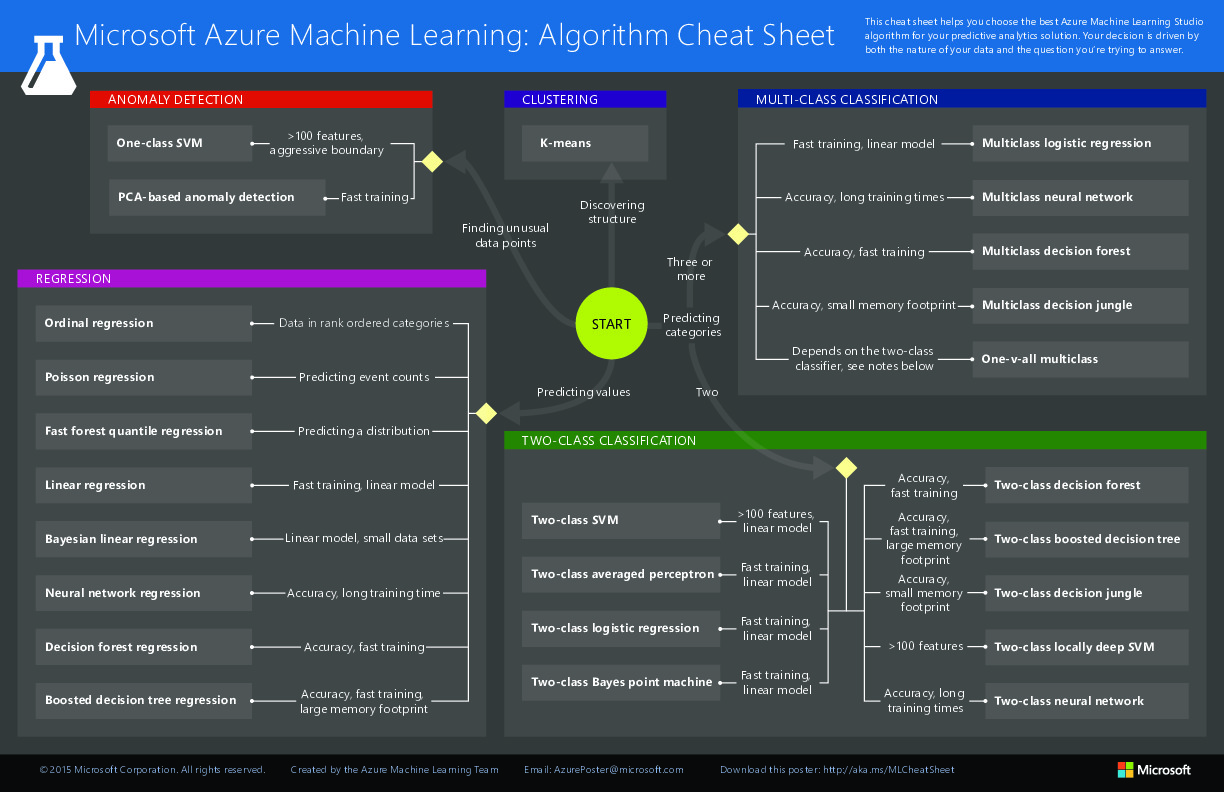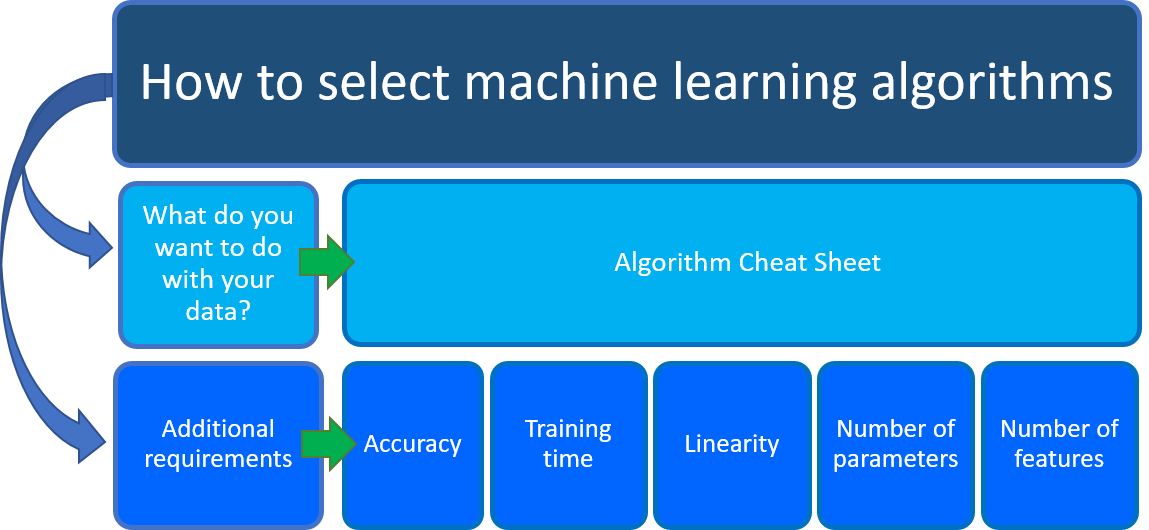Machine learning algorithm cheat sheet for Microsoft Azure Machine Learning Studio SAS Algorithm Flowchart. A module might contain a particular algorithm, or perform a task that is important in machine learning, such as missing value replacement, or statistical analysis. For help with choosing algorithms, see. How to select algorithms; Azure Machine Learning Algorithm Cheat Sheet. Figure 3: Microsoft’s Machine Learning Algorithm Cheat Sheet A second challenge in implementing a machine-learning model is coding the algorithm. Azure Machine Learning helps out in this regard by providing canned implementations of 25 of the most commonly used algorithms in machine learning. The goal is to make machine learning.


This is part of the Machine Learning series.
Azure Machine Learning documentation. Learn how to train, deploy, & manage machine learning models, use AutoML, and run pipelines at scale with Azure Machine Learning. Tutorials, code examples, API references, and more show you how. This cheat sheet helps you choose the best Azure Machine Learning Studio algorithm for your predictive analytics solution. Your decision is driven by both the nature of your data and the question you’re trying to answer. START No Yes Categories Predict future data points? K-means Yes Values Predict categories or values? Data in rank-ordered.
One question that always pops up in any machine learning problem: Which algorithm should I use? What do the algorithms do anyways?
For this purpose, I got to interview the Channel 9 guru Seth Juarez (@sethjuarez) who happens to be as passionate about machine learning as I am:
After briefly going over a typical machine learning process, we have a closer look at third step, i.e. building the model:
What algorithms are out there? Which one should we use? What do they do? Thus, we covered the most common algorithms in machine learning problems - and on top of that we used some fancy visualisations to explain their doing:

- Perceptron (in AzureML: Two-Class Averaged Perceptron)
- Kernel perceptron (aka Support Vector Machines); in AzureML: Two-Class Support Vector Machine and Two-Class Locally-Deep Support Vector Machine
- Decision Trees
- Neural Netowrks
- Deep Learning
One of Microsoft's Data Scientist, Brandon Rohrer, has written a nice three-part blog series on introducing data science with no jargon:
- What Can Data Science Do For Me? Brandon explains what prerequisites are necessary for a good start of a machine learning project.
- What Types of Questions Can Data Science Answer? Here, Brandon goes through typical questions that can be covered by the three extended algorithm families:
- Supervised learning (e.g. classification, anomaly detection, regression),
- Unsupervised learning (e.g. clustering and dimensionality reduction), and
- Reinforcement learning.
- Which Algorithm Family Can Answer My Question? Brandon gives a good overview of typical questions asked in the following areas, and which algorithm to use then:
- Predictive Maintenance
- Marketing
- Finance
- Operational Efficiency
- Energy Forecasting
- Internet of Things
- Text and Speech Processing
- Image Processing and Computer Vision
Furthermore, there is one really neat cheat sheet created by Microsoft's Data Science team on when to use which algorithm:
Finally, one last resource that I hihgly recommend: Top 10 data mining algorithms in plain English. This article explains the 10 most influential algorithms (voted by 3 separate panels):
- C4.5 (decision tree)
- k-means (clustering)
- Support vector machines (next to C4.5, a classifier to try out first)
- Apriori (association rule learning --> recommendation engine)
- EM (i.e. expectation-maximization for clustering)
- PageRank (network analysis; think of the PageRank in Google's search engine)
- AdaBoost (boosting, and thus an ensemble learning algorithm; taking in and combining multiple learning algorithm)
- kNN (aka k-Nearest Neighbors, thus classification)
- Naive Bayes (family of classification algorithms assuming that all features is independent of each other)
- CART (aka classification and regression trees, thus a classifier)
This list contains algorithms of various algorithm families, including association rule learning (relevant for building recommenders).
-->Tahákový list s algoritmem Azure Machine Learning vám pomůže vybrat správný algoritmus z návrháře pro model prediktivní analýzy.The Azure Machine Learning Algorithm Cheat Sheet helps you choose the right algorithm from the designer for a predictive analytics model.
Azure Machine Learning má rozsáhlou knihovnu algoritmů z třídy klasifikace _, _doporučované systémy_, _clustering_, _detekce anomálií_, _regrese_ a _ Text Analytics rodiny.Azure Machine Learning has a large library of algorithms from the classification _, _recommender systems_, _clustering_, _anomaly detection_, _regression_, and _ text analytics families.Každá z nich je navržena tak, aby se vyřešil jiný typ problému strojového učení.Each is designed to address a different type of machine learning problem.
Další pokyny najdete v tématu postup výběru algoritmů .For additional guidance, see How to select algorithms
Stažení: Tahákický list s algoritmem Machine LearningDownload: Machine Learning Algorithm Cheat Sheet
Stáhněte si tahák list sem: Machine Learning tahák Algorithm list (11x17 in.)Download the cheat sheet here: Machine Learning Algorithm Cheat Sheet (11x17 in.)
Stáhněte a vytiskněte Tahákový list s algoritmem Machine Learning v Tabloid velikosti, abyste ho zachovali a mohli získat pomoc s výběrem algoritmu.Download and print the Machine Learning Algorithm Cheat Sheet in tabloid size to keep it handy and get help choosing an algorithm.
Jak používat Tahákový list s algoritmem Machine LearningHow to use the Machine Learning Algorithm Cheat Sheet
Návrhy nabízené v tomto tahák listu algoritmu jsou přibližné.The suggestions offered in this algorithm cheat sheet are approximate rules-of-thumb.Některé mohou být ohnuty a některé mohou být flagrantly porušeny.Some can be bent, and some can be flagrantly violated.Tento tahák list je určen pro návrh počátečního bodu.This cheat sheet is intended to suggest a starting point.Nemusíte být Nebojte, aby se spouštěla soutěž vedoucí na hlavu mezi několika algoritmy na vašich datech.Don’t be afraid to run a head-to-head competition between several algorithms on your data.Neexistuje žádná náhrada za porozumění principům každého algoritmu a systému, který vygeneroval vaše data.There is simply no substitute for understanding the principles of each algorithm and the system that generated your data.
Azure Machine Learning Algorithm Cheat Sheet 2020
Každý algoritmus strojového učení má svůj vlastní styl nebo inductiveový posun.Every machine learning algorithm has its own style or inductive bias.V případě konkrétního problému může být vhodné několik algoritmů a jeden algoritmus může být lepší, než ostatní.For a specific problem, several algorithms may be appropriate, and one algorithm may be a better fit than others.Není ale vždy možné znát, který z nich nejlépe vyhovuje.But it's not always possible to know beforehand which is the best fit.V podobných případech je v listu tahák uvedeno několik algoritmů.In cases like these, several algorithms are listed together in the cheat sheet.Vhodnou strategií by bylo vyzkoušet jeden algoritmus a pokud výsledky ještě nejsou uspokojivé, zkuste jiné.An appropriate strategy would be to try one algorithm, and if the results are not yet satisfactory, try the others.
Pokud chcete získat další informace o algoritmech v Návrháři Azure Machine Learning, přečtěte si odkaz na algoritmus a modul.To learn more about the algorithms in Azure Machine Learning designer, go to the Algorithm and module reference.
Druhy strojového učeníKinds of machine learning
Existují tři hlavní kategorie strojového učení: dohled nad dohledem, vzdělávání bez dohledu a posílení učení.There are three main categories of machine learning: supervised learning, unsupervised learning, and reinforcement learning.
Azure Machine Learning Algorithm Cheat Sheet 2019
Vzdělávání pod dohledemSupervised learning
V dohledovém učení je každý datový bod označený nebo přidružený ke kategorii nebo hodnotě, které vás zajímají.In supervised learning, each data point is labeled or associated with a category or value of interest.Příkladem popisku kategorií je přiřazení obrázku jako 'Cat' nebo 'pes'.An example of a categorical label is assigning an image as either a ‘cat’ or a ‘dog’.Příkladem popisku hodnoty je prodejní cena spojená s použitým automobilem.An example of a value label is the sale price associated with a used car.Cílem učení pod dohledem je prozkoumat mnoho příkladů s označením, jako jsou tyto, a pak předpovědi o budoucích datových bodech.The goal of supervised learning is to study many labeled examples like these, and then to be able to make predictions about future data points.Můžete například identifikovat nové fotografie se správným zvířetem nebo přiřadit přesné prodejní ceny jiným využitým automobily.For example, identifying new photos with the correct animal or assigning accurate sale prices to other used cars.Toto je oblíbený a užitečný typ strojového učení.This is a popular and useful type of machine learning.
Vzdělávání bez dohleduUnsupervised learning
V bezdohledovém učení se k datovým bodům nevztahují žádné popisky.In unsupervised learning, data points have no labels associated with them.Místo toho je cílem nesledovaného výukového algoritmu způsob, jak uspořádat data nějakým způsobem nebo popsat její strukturu.Instead, the goal of an unsupervised learning algorithm is to organize the data in some way or to describe its structure.Data studijních skupin, která nejsou v režimu pod dohledem, jsou v clusterech, stejně jako to znamená, nebo naleznou různé způsoby prohlížení složitých dat tak, aby se zjednodušilo.Unsupervised learning groups data into clusters, as K-means does, or finds different ways of looking at complex data so that it appears simpler.
Zpětnovazební učeníReinforcement learning
V procesu posílení učení se algoritmus při reakci na každý datový bod vybere jako akce.In reinforcement learning, the algorithm gets to choose an action in response to each data point.Jedná se o běžný přístup v robotech, kde je sada čtení snímačů v určitém bodě v čase datovým bodem a algoritmus musí zvolit další akci robota.It is a common approach in robotics, where the set of sensor readings at one point in time is a data point, and the algorithm must choose the robot’s next action.Je to také přirozené přizpůsobení Internet věcí aplikacím.It's also a natural fit for Internet of Things applications.Výukový algoritmus také obdrží krátkou dobu a později indikuje, jak dobrá bylo rozhodnutí.The learning algorithm also receives a reward signal a short time later, indicating how good the decision was.Na základě tohoto signálu algoritmus mění svoji strategii, aby dosáhl nejvyšší odměny.Based on this signal, the algorithm modifies its strategy in order to achieve the highest reward.
Microsoft Azure Machine Learning Cheat Sheet
Další krokyNext steps
Azure Machine Learning Algorithm Cheat Sheet 2017
Podívejte se na další pokyny k výběru algoritmůSee additional guidance on How to select algorithms
Přečtěte si o studiu v Azure Machine Learning a Azure Portal.Learn about studio in Azure Machine Learning and the Azure portal.
Kurz: sestavení modelu předpovědi v návrháři Azure Machine Learning.Tutorial: Build a prediction model in Azure Machine Learning designer.
Seznamte se s hloubkovým učením a strojovým učením.Learn about deep learning vs. machine learning.
